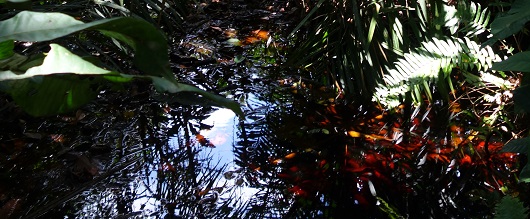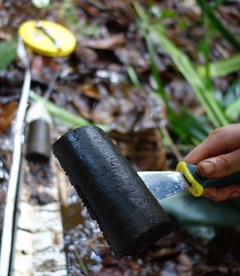New mapping reveals vast peatlands in the Congo Basin

A previously unmapped peatland complex in central Africa is vulnerable to agriculture and climate change and should be protected, research suggests.
Detailed mapping of one of the world’s biggest swamp forests shows that it contains huge amounts of peat, covering 145,500 square kilometres – an area almost twice the size of Scotland.
The discovery, in the central Congo Basin, confirms the area as the most extensive peatland complex in the tropics.
Scientists who made the discovery say the soils – estimated to contain about 30 billion tonnes of carbon – should be the focus of conservation efforts.
If the swamps were to be drained for development, or were to dry out from lack of rain or increases in temperature owing to climate change, carbon in the peat would be exposed to the atmosphere. The peat would then decay, releasing significant amounts of greenhouse gases, contributing to climate change and accelerating the rate of global warming, scientists warn.
Researchers used data from imaging and radar satellites to chart the waterlogged area. By mapping vegetation associated with peaty soils, and manually measuring peat depth at hundreds of locations in the Republic of Congo, they were able to estimate the peat content below ground across the landscape.
Their findings show that the peat bogs began to form about 10,000 years ago, at the end of the last ice age.
The study, led by the University of Leeds, was carried out with University College London, the Universities of St Andrews, Edinburgh and Leicester and the Université Marien Ngouabi in Brazzaville. It was published in Nature and supported by the Natural Environment Research Council.
 Dr Ian Lawson of the School of Geography and Sustainable Development at St Andrews, who co-authored the study, said: “It’s becoming clear that peat is much more widespread in the tropics than we thought. Our previous research on similar, but smaller peatlands in Amazonia has helped to stimulate sustainable development efforts there to protect carbon stocks and support the people who live on their fringes. In the Congo Basin there’s great potential to do the same on a much larger scale.
Dr Ian Lawson of the School of Geography and Sustainable Development at St Andrews, who co-authored the study, said: “It’s becoming clear that peat is much more widespread in the tropics than we thought. Our previous research on similar, but smaller peatlands in Amazonia has helped to stimulate sustainable development efforts there to protect carbon stocks and support the people who live on their fringes. In the Congo Basin there’s great potential to do the same on a much larger scale.
“Peatlands across the world have been damaged and destroyed over many centuries, including in the British Isles, without the level of understanding of the implications that we have today. At the moment it’s a particularly live issue in some parts of the tropics. Simply knowing that peatlands exist in the Congo Basin is an important step towards avoiding their destruction.
“Over the last few decades, peat swamps in places like Indonesia have been deforested and drained for agriculture on a very large scale. The resulting carbon emissions are deeply concerning, but so are the other consequences such as the health effects of smoke haze from burning peat and the loss of habitat for animals like orang-utans.
“Protecting peatlands across the globe is going to need action on many fronts, not least pressure from consumers to ensure that agricultural companies act responsibly.”
Notes to news editors
Issued by the University of St Andrews Communications Office, contactable on 01334 467310 or [email protected].
Category Research